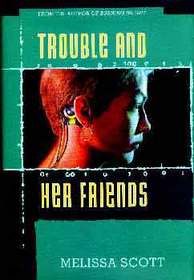
Trouble and Her Friends
Melissa Scott
379 pages
published in 1994
Trouble and Her Friends is the tenth book I’ve read in my Year of Reading Women project and the first and only cyberpunk novel in the bunch. It’s a book I’ve long wanted to read, having heard nothing but praise for it over the years and seeing it compared to e.g. Pat Cadigan’s cyberpunk novels. As I started reading it, there were two minor things that disappointed me: the first was the publication date, 1994, much later than I though, the second was the tendency of the covers to flake, something it has in common with other Tor books of that period. I’d always assumed Trouble and Her Friends had been published in the mid-eighties; certainly the setting is very eighties.
This matters because it means that not only is its future dated now, but it was already obsolete when it was first published. Trouble and Her Friends‘s vision of cyberspace is essentially an eighties one, where it’s important but largely unused by regular people, divided into discrete blocks owned by huge multinationals and hidden behind ICE (Intrusion Countermeasures (Electronic)) to ward off hackers, who seem to be the only people behind corporate drones to use cyberspace. It’s obviously inspired by the BBS scenes of the eighties and indeed the main hacker hangout is called the BBS. Yet 1994 was the year the internet fully broke into the public consciousness, when it should’ve become clear that it’s the openness of the internet and interaction with other people on it that are its greatest strengths, far removed from the lonely adventures of isolated hackers battling in virtual reality with faceless corporate ICE software that most cyberpunk, including Trouble and Her Friends, offers — it’s probably no coincidence that it largely died as a subgenre in the mid nineties. What saves Trouble and Her Friends from complete obsolescence can be summed up in one word: politics.